Tobacco
See also: Randalstown: St. Anne's Church and Holy Well and Everard, Randalstown.
Navan Tobacco
Today, little evidence remains of the tobacco industry that once flourished in the Randlestown area of Navan. In the first quarter of the 1900s it provided jobs for nearly 100 people and played an important part in the local economy.
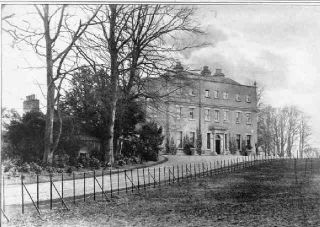
The industry centred on the old Randlestown estate
(Randlestown House left, which today is beneath the waters of the Tara Mines Tailings Dam)
which had a tobacco plantation covering more than 100 acres. It was a bustling place which took in cartloads of tobacco from local farmers and processed them for sale to the factories. Surprisingly, this episode in Navan’s history is almost forgotten.
The Randlestown tobacco industry, which once employed nearly 100 people, had its roots in the imagination of one remarkable landowner, Sir Nugent Everard, (below right) who conducted the first tobacco growing experiments in Meath in 1898, and who was a man ahead of his time.
He lived in splendour on the 300 acre Randlestown estate and was in many ways a typical Anglo-Irish aristocrat, but he had a progressive and sometimes pioneering approach in farming and insisted that his main interest was in providing jobs. For nearly 30 years, Sir Nugent pursued his vision of tobacco industry in Meath. He succeeded for a while. At one time, his estate was a hub of tobacco production: it had a plantation covering more than 100 acres and it housed expensive “rehandling” machines which prepared plants for market. In addition, the estate bought in plants from a network of small growers in the 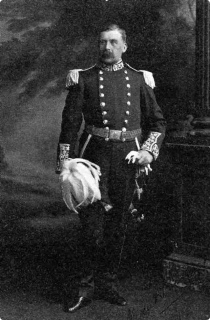 district.
district.
By the time Sir Nugent died in 1929, however, the heyday of tobacco growing in Meath had passed. Unfavourable government policies were blamed for the decline. Locals revived the industry in the 1930s but their success was short-lived. The obstacle to tobacco growing in Ireland, Sir Nugent had once said, had never been climatic but was solely and entirely political.
From the start, he had been convinced that tobacco could be cultivated successfully in Meath. Within five years of his first experiments, he won permission from the Government to plant 20 acres of tobacco. He sent his son Major Richard, to the United States to learn all he could about the subject and, in 1904, he oversaw what John Nevin called “the beginning of a great scheme for the employment of labour,” on the estate. Nevin was under steward at Randlestown.
He described later how the scheme provided jobs not just for working men, but their families: “Nearly all the operations gave light work, even children during their school holidays taking part in weeding operations. This enabled many parents to keep their children at home instead of sending them out to service or across the sea .... We grew all classes of tobacco – cigars, cigarettes and pipe with great success. Strangers came to visit the plantation from many foreign countries and were much impressed, especially Americans, with our knowledge of tobacco growing.”
By 1910, the operation was working so well the Department of Agriculture introduced a small growers’ scheme. This allowed local farmers grow tobacco on plots from half an acre to one acre. According to John Nevin, the number of small growers increased quickly from 10 to 48 as they saw the results, achieved by their neighbours. Every description of soil – “even pure bog soil” was used with great success, he said. Land was heavily manured in preparation for planting and this had an added benefit for farmers. The enriched soil was able to grow wheat for the first time in many areas. As cultivation of tobacco spread according to Nevin, “such a thing as emigration became unknown in his district.”
In 1914, the Land Development Commissions introduced an extension of the growers’ scheme. John Nevin canvassed for growers for 114 acres in various parts of Meath and Louth and secured a total of 71. A curing barn was built on each holding. These barns, some of which were still standing as recently as the 1970s, were used for drying and curing the plants before transfer to the central rehandling station at Randlestown estate.
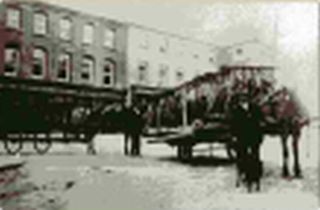 Nevin visited each grower to check the crops. He owned one of the few motorcycles in the district and soon became a familiar sight touring the farms around Randlestown and Kilberry.
Nevin visited each grower to check the crops. He owned one of the few motorcycles in the district and soon became a familiar sight touring the farms around Randlestown and Kilberry.
According to Major Richard Everard, “a careful and industrious” smallholder made a profit of between £15 and £30 an acre on the tobacco crops between 1914 and 1919. [By comparison, labourers on the estate were being paid about 50p for a 60 hour week].
(left) Tobacco in Navan's Market Sq. at turn of 20th century.
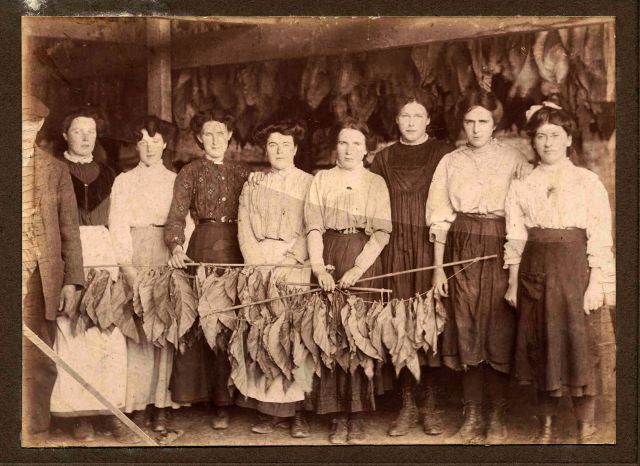
Randlestown Tobacco Station Employees c. 1914 Photo courtesy Meath Co. Library & Archive Services
In the period 1900 to 1919, employment in the industry rose from 12 to nearly 100 and the yearly wage bill increased from £300 to £2,500. Up to 1919, home grown tobacco was easily sold to cigarette makers in Ireland and to several in England and Scotland at about the same price as a similar grade of American. According to Major Richard, experts liked it because it was suitable for blending with American tobacco.
But in 1919 the home grown industry suffered a blow from which it never fully recovered. The Government introduced a subsidy for tobacco growers. This had the effect of bringing Irish tobacco into direct competition with surplus tobacco grown cheaply in far-flung British colonies. Manufacturers preferred the cheaper product.
John Nevin reported: “I acted as traveller for the Irish Tobacco Company in Co. Meath and found that Irish tobacco was much appreciated, but owing to the inducements given to retailers by the Imperial Tobacco Co., it was impossible for the Irish Tobacco Company to compete.”
In 1923, the Free State Government tried to tip the scales in favour of the home-grown industry by making imported tobacco less attractive. But this apparently turned many manufacturers against the Irish product. The government stopped grant-aiding the home-grown industry in 1923.
In 1926, a Dail Special Committee recommended reducing duty to ensure a profitable market for home-grown tobacco, but there was no such relief until the change of government in 1932. By then, it was too late to benefit the founder of the Randlestown tobacco industry. Sir Nugent had died in 1929, aged 80. His son Richard, always a heavy drinker, died just 11 days later. Several attempts were made to revive the industry after Sir Nugent’s death.
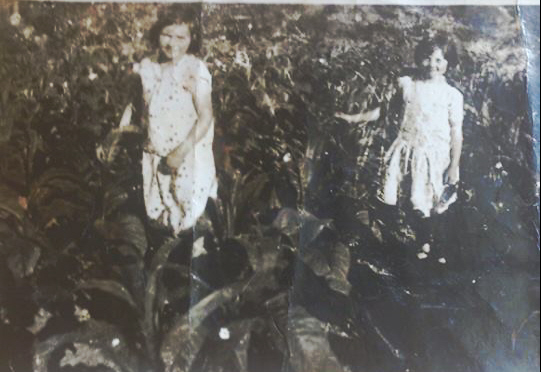
In May 1932 a meeting of interested parties took place in the Banba Hall, Navan. Among those present was Michael Markey, chairman of the old Tobacco Growers’ Association.
He pointed out that, with home-grown tobacco relieved of duty, [a step taken by the new Fianna Fail government] “a situation full of possibilities” had opened up for small farmers in Meath.
He said the previous government seemed to have considered tobacco growers a nuisance and had put obstacles in their path.
(above) Nancy & Cecilia Smith Lynch in their father's tobacco field. Photo courtesy Anne O'Hare
Major Metge, brother-in-law of Sir Nugent and executor of his state, blamed treasury officials. He said they had killed the industry and had not listened to any reasonable 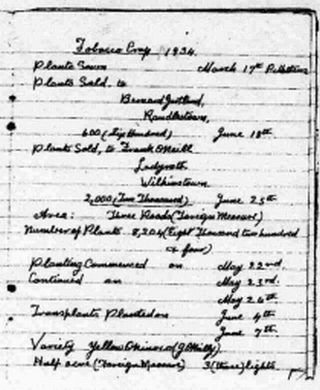 scheme for putting extra duty on foreign tobacco. Major Metge also pointed out that there was no guarantee tobacco might not be taxed again. He told the meeting that up to 40,000lbs of home-grown tobacco was in bonded warehouses and would not be released until duty had been paid on it. Some belonged to the Everard estate, the rest to local growers. Some time after this meeting [it is not clear when] the industry was revived and a Meath Cooperative Tobacco Grower’s Society was formed.
scheme for putting extra duty on foreign tobacco. Major Metge also pointed out that there was no guarantee tobacco might not be taxed again. He told the meeting that up to 40,000lbs of home-grown tobacco was in bonded warehouses and would not be released until duty had been paid on it. Some belonged to the Everard estate, the rest to local growers. Some time after this meeting [it is not clear when] the industry was revived and a Meath Cooperative Tobacco Grower’s Society was formed.
One local grower, John Mangan from Windtown kept detailed records of his tobacco crops at this time. (right)
They show that he sowed a crop in 1934 and sold the tobacco to Bernard Gartland, Randlestown, and Frank O’Neill, Ladyrath, Wilkinstown.
The following year he sold two varieties, Yellow Prior and Orinoco, and sold much of his harvest to the Co.Cork T.D., Martin Corry.
Mr. Mangan’s records show that he planted no more tobacco after the 1935 harvest. Total tobacco acreage in Meath had fallen to 89 by 1936 and it is likely this was the final year the crop was grown in Randlestown.
Source: The Tobacco Fields of Meath Liam Nevin www.The Authors Friend.com
*******
The Times, 7 July 1904 ~ House of Commons
Mr. Wyndham- In 1900, 1901 and 1902 experiments under the supervision of the Department were undertaken at a number of selected centres in Ireland, the result of which have satisfied the Department that the tobacco plant can be successfully cultivated in that country. In order, however, to determine the possible commercial value to the country of tobacco cultivation, arrangements were made for the growing of the crop on about 20 acres in the vicinity of Navan during the present year...
The Times, 29 June 1905 ~ Tobacco. House of Commons. Irish Tobacco.
The Departments advisory committee on tobacco recommended that the experiment in 1904 should be confined to one centre - namely Navan - and that at least 20 acres should be grown there. Others in the district having declined to offer land for the purpose Colonel Everard undertook to plant the entire 20 acres, and consequently he was the only approved grower entitled to the rebate.
The Times, 9 Oct 1905 ~
At a special meeting of the Irish Industrial Development Association Mr. R.E. Goodbody made an interesting statement about the Irish tobacco crop for 1905. In company with an American expert, he had just visited Randlestown, Navan, where Colonel Everard had ten acres under process of saving. He had never seen so good a yield in any country, and the expert was of the same opinion. The yield of the ten acres was three times as great as that from a twenty plot last year. The tobacco was a little slow in saving but smoked very well. More than 3,000 hands were employed in Irish tobacco factories.
The Times, 9 July 1906 ~
The experiments in tobacco growing in Ireland, which have now been carried out for several years by Colonel Nugent T. Everard, of Randlestown, Navan, County Meath, appear to have been brought to a successful termination and to have emerged from the experimental stage into an actual industry. The following particulars have been forwarded to us: - In 1904 Colonel Everard, grew 20 acres of tobacco, which yielded 9,000 lbs. of cured leaf. It was favourably reported on by experts and sold freely at ½ per lb. above the same class of American tobacco. In 1905 13 ½ acres were grown by Colonel Everard which yielded 15,500 lb... This year Colonel Everard is experimenting upon 25 varieties, including high class cigar wrappers, and judging from the characteristics developed in the tobacco previously grown the experiment is likely to prove a success.
“With our present experience” writes Captain R. W. Everard “the cost of labour on one acre of tobacco is about £20 per acre, about half of which can be earned by women and boys during the winter, when in this country, there is no other employment for them”.